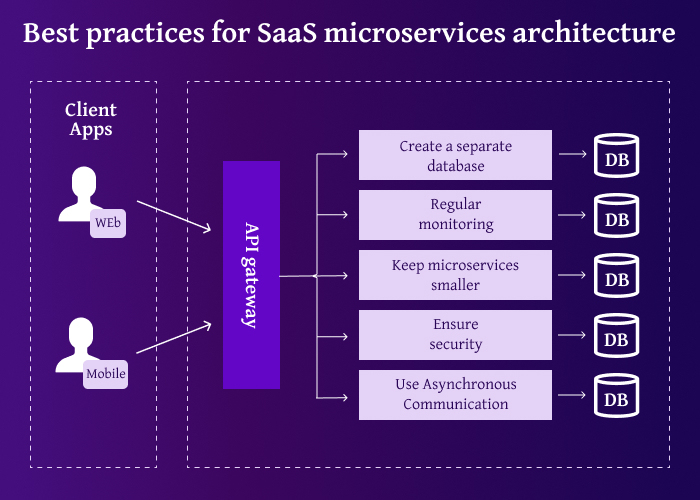What is microservices architecture?
It is a general question for non-techs –what are microservices? Microservices, also known as microservices architecture is an app’s structural approach where independent services are loosely connected and communicate with lightweight protocols.
Due to the smaller and divided codebase, deployment is quicker and more cost-effective. Furthermore, detecting and troubleshooting a mistake is also considerably easier because there is less code to look for.
Since one service operates independently of the others, it is possible to add new components or improve existing ones without affecting the app as a whole. Different tech stacks can be used for each module, based on what works best for the teams.
Furthermore, the DevOps team can investigate each service independently and build, deploy, and test with agility thanks to the microservices design. When every module is operating well on its own, there is no obstacle, which boosts attention and improves the apps’ total performance.
However, selecting many frameworks might make deployment more difficult. Although API calls are used to manage microservices architecture, building separate scripts for each framework can eventually become uncontrollable and resource-intensive. Thus, select constrained frameworks per your needs.
Best practices for SaaS microservices architecture

- Create a separate database: Mostly, many developers use a single database for microservices architecture. Thus, it disregards the use of microservices, and scalability is not found. In solution to this, allow each microservice to access an independent database separated from other services. This also helps in finding errors and not letting other databases get affected by errors in a single service.
- Regular monitoring: As the number of modules increases, the architecture becomes complex. Thus, developers need to look into the synchronization and seamless functionality of the architecture. Regular checkups and monitoring help in knowing errors on time at any point. You can integrate SDKs or plugins to monitor them accurately.
- Keep microservices smaller: This involves allowing less or limited load on a microservice to function smoothly and less complicated. Furthermore, the smaller the microservice, the easier to manage. Additionally, as mentioned earlier, if a certain service stops working, it won’t affect the app as a whole. Restricted logical functionalities make a program easier to use and less disruptive.
- Ensure security: The complexity and requirement for security grow as the number of microservices rises. Thus, a centralized system is required to prevent attacks, whether they originate from malicious robots or erroneous programming. Installing a system with plugins is necessary to handle security protocols such as authorization and authentication.
- Use Asynchronous Communication: It helps in prioritizing the queues by isolating microservices. Thus, asynchronous communication reduces the load and is more helpful during technical faults.
Microservices interview questions
Make sure the microservices architecture services provider you choose has the knowledge and resources necessary to handle the demands of your company. The following interview questions can be used to assess possible agencies:
- How does your agency collaborate with clients throughout the microservices project lifecycle?
- Can you provide an overview of your experience in designing and implementing microservices?
- What methodologies and frameworks do you follow when designing microservices architectures?
- What roles and expertise are typically involved in your microservices architecture projects?
- How do you evaluate and select technologies for a microservices project?
- Can you discuss your approach to load balancing, caching, and distributed computing in microservices deployments?
- How do you ensure client satisfaction and long-term success with the microservices solutions you deliver?
- What level of support and maintenance services does your agency offer for microservices post-deployment?
Conclusion
For SaaS product development, microservices architecture has several advantages. For example, continuous delivery, scalability, flexibility, robustness, and diversity of technologies.
Adopting microservices can present some difficulties, but these can be overcome with proper planning, execution, and the adoption of best practices. These difficulties include complexity, communication overhead, data management, and organizational alignment.
Organizations may create and deliver creative and scalable SaaS solutions to satisfy changing consumer demands by utilizing DevOps ideas and techniques to manage and maintain microservices systems.
FAQs
What are Microservices Architecture and its relevance to SaaS product development?
Microservices architecture is an architectural style that structures an application as a collection of loosely coupled services, each focused on a specific business capability. In the context of SaaS product development, microservices enable the creation of modular, scalable, and maintainable software solutions by breaking down the application into smaller, independent services.
What are the 3 C's of microservices?
Componentize, collaborate, and connect are the three Cs of microservices architecture
What challenges might be encountered when adopting Microservices Architecture for SaaS product development?
- Managing a distributed system composed of multiple services introduces complexity in areas such as deployment, monitoring, and debugging.
- Effective communication between microservices is crucial but can be challenging to implement and maintain, especially in large-scale systems.
- Coordinating data across multiple services while ensuring consistency and integrity can be complex, requiring careful planning and implementation.
- Adopting microservices often requires organizational changes to align teams with service boundaries, which can impact communication and collaboration.
How are security and compliance addressed in Microservices Architecture for SaaS?
- Implement security best practices such as authentication, authorization, encryption, and secure communication protocols at both the service level and the infrastructure level.
- Ensure that microservices architecture adheres to relevant compliance requirements such as GDPR, HIPAA, or industry-specific regulations by implementing appropriate data handling and access controls.
What role does DevOps play in supporting Microservices Architecture for SaaS development?
DevOps practices such as automation, continuous integration, delivery, and infrastructure as code are crucial for managing microservices environments effectively.
Ravi Bhojani is the Chief Marketing Officer (CMO) at Alian Software, where he spearheads the company’s marketing strategies and drives its brand presence in the competitive IT services landscape. With over a decade of experience in the technology and marketing sectors, Ravi has consistently demonstrated his ability to blend innovative marketing techniques with deep industry knowledge to deliver outstanding results.